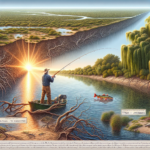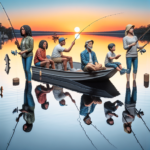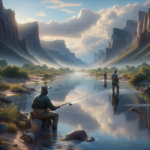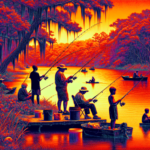Fishing in the Red River: Best Spots from Texas to Louisiana

Introduction
Did you know that the Red River, stretching from Texas to Louisiana, is home to some of the most diverse and abundant fishing opportunities in the United States? Whether you’re an experienced angler or a novice looking to cast your first line, the Red River offers a variety of fishing spots that cater to all skill levels. This article will guide you through the best fishing spots along the Red River, from Texas to Louisiana, covering essential techniques, species information, and practical tips to enhance your fishing experience.
Fishing in the Red River is not just about the thrill of the catch; it’s also about connecting with nature, understanding local ecosystems, and enjoying the serene landscapes that this river has to offer. By the end of this article, you’ll be well-equipped with the knowledge to make your next fishing trip to the Red River a memorable one.
Background/Context
Historical or Cultural Significance
The Red River has played a significant role in the history and culture of the regions it flows through. Historically, it served as a vital waterway for Native American tribes and early European settlers. The river’s rich biodiversity has made it a crucial resource for fishing, agriculture, and transportation. Today, it continues to be a popular destination for recreational fishing, attracting anglers from all over the country.
Geographical Overview
The Red River originates in the Texas Panhandle and flows southeast through Texas, forming the border between Texas and Oklahoma, before continuing into Louisiana. The river’s diverse ecosystem includes a variety of habitats such as wetlands, forests, and grasslands, which support a wide range of fish species. The climate along the Red River varies from semi-arid in the upper regions to humid subtropical in the lower regions, influencing the types of fish and fishing conditions you can expect.
Key Points/Details
Fishing Techniques
Technique Overview
Fishing in the Red River can be done using various techniques, including bank fishing, boat fishing, and fly fishing. Each technique has its own set of advantages and is suited to different parts of the river and types of fish.
When and Where to Use
Bank fishing is ideal for accessible spots along the riverbanks, especially in areas with shallow waters. Boat fishing allows you to reach deeper parts of the river and is particularly effective in wider sections. Fly fishing is best suited for areas with clear water and abundant insect life, such as tributaries and smaller streams feeding into the Red River.
Recommended Gear
- Rods and Reels: Medium to heavy rods with spinning or baitcasting reels are recommended for most fishing in the Red River.
- Lines: Use braided or monofilament lines with a test strength of 10-20 pounds, depending on the target species.
- Bait/Lures: Live bait such as worms and minnows, as well as artificial lures like crankbaits, spinnerbaits, and jigs, are effective.
Species Information
Species Overview
The Red River is home to a variety of fish species, including catfish, bass, crappie, and sunfish. Each species has its own habits and preferred habitats, making the river a versatile fishing destination.
Best Practices
- Catfish: Use stink baits or cut baits near deep holes and submerged structures. Night fishing is particularly effective.
- Bass: Target bass near rocky outcrops, submerged vegetation, and fallen trees using crankbaits and soft plastics.
- Crappie: Fish around brush piles and submerged timber using small jigs or live minnows.
- Sunfish: Use small hooks and live bait like worms or crickets near shallow, weedy areas.
Location Information
Top Fishing Spots
- Lake Texoma: Located on the Texas-Oklahoma border, this lake is known for its excellent striper fishing.
- Denison Dam: Below the dam, the tailwaters are a hotspot for catfish and bass.
- Shreveport-Bossier City: This area in Louisiana offers numerous access points and is known for its diverse fish population.
- Red River National Wildlife Refuge: Located near Bossier City, this refuge provides excellent bank fishing opportunities.
Regulations and Licenses
Fishing regulations vary between Texas and Louisiana, so it’s essential to check local rules before heading out. Both states require a fishing license, which can be purchased online or at local retailers. Be aware of specific regulations regarding catch limits, size limits, and seasonal restrictions to ensure a legal and sustainable fishing experience.
Seasonal Considerations
Seasonal Variations
Fishing conditions on the Red River change throughout the year. Spring and fall are generally the best seasons for fishing, with moderate temperatures and active fish. Summer can be productive but requires early morning or late evening fishing to avoid the heat. Winter fishing is possible but may require more patience and specialized gear.
Best Times to Fish
The optimal times to fish are early morning and late evening when fish are most active. During the spring and fall, midday fishing can also be productive. Pay attention to weather patterns and water levels, as these can significantly impact fish behavior.
Events and Tournaments
Event Overview
The Red River hosts several fishing tournaments throughout the year, attracting anglers from across the country. Notable events include the Red River Shootout and the Bassmaster Classic, which offer substantial prizes and the opportunity to compete against top anglers.
Preparation Tips
- Register early to secure your spot in popular tournaments.
- Practice in the tournament area to familiarize yourself with local conditions.
- Ensure your gear is in top condition and bring backup equipment.
- Study past tournament results to identify successful strategies and locations.
Tips and Best Practices
General Tips
- Always check local weather and water conditions before heading out.
- Keep a fishing log to track successful spots, techniques, and conditions.
- Respect private property and obtain permission if necessary.
Avoid Common Mistakes
- Not checking local regulations: Always ensure you are aware of and comply with local fishing laws.
- Using the wrong gear: Match your gear to the target species and fishing conditions.
- Ignoring safety: Always wear a life jacket when boating and be aware of your surroundings.
Advanced Techniques
- Drift Fishing: Use this technique in deeper sections of the river to cover more area and locate active fish.
- Vertical Jigging: Effective for targeting fish near submerged structures or in deep holes.
- Topwater Fishing: Use topwater lures during low-light conditions for an exciting and visually rewarding experience.
Gear and Equipment Recommendations
Essential Gear
- Medium to heavy rods and reels
- Braided or monofilament lines (10-20 lb test)
- Variety of lures and baits (crankbaits, spinnerbaits, jigs, live bait)
- Tackle box with essential tools (pliers, line cutters, hooks)
- Fishing license for Texas or Louisiana
Optional Gear/Upgrades
- Fish finder or depth sounder for boat fishing
- Waders for fly fishing in shallow areas
- Portable cooler for storing your catch
- Fishing kayak or small boat for accessing remote spots
Where to Buy or Rent
Local bait and tackle shops in towns along the Red River are excellent places to purchase or rent gear. Additionally, major outdoor retailers like Bass Pro Shops and Cabela’s have locations in Texas and Louisiana, offering a wide range of fishing equipment.
Safety and Conservation
Safety Tips
- Always wear a life jacket when on a boat or near deep water.
- Be aware of weather conditions and avoid fishing during storms or high winds.
- Carry a first aid kit and know basic first aid procedures.
- Stay hydrated and protect yourself from the sun with appropriate clothing and sunscreen.
Conservation Practices
- Practice catch and release to help maintain fish populations.
- Follow local regulations regarding catch limits and size restrictions.
- Dispose of fishing line and other waste properly to protect wildlife.
- Respect natural habitats and avoid disturbing vegetation and wildlife.
Planning Your Trip
Accommodations
There are numerous lodging options near popular fishing spots along the Red River. From campgrounds and RV parks to hotels and vacation rentals, you’ll find accommodations to suit any preference and budget. Notable options include Lake Texoma State Park, Shreveport-Bossier City hotels, and various campgrounds along the river.
Travel Tips
- Plan your route in advance and check for any road closures or construction.
- Consider renting a vehicle if you plan to explore multiple fishing spots.
- Pack essential supplies, including food, water, and emergency gear.
Additional Activities
If you’re traveling with family or friends who may not be as enthusiastic about fishing, there are plenty of other activities to enjoy along the Red River. These include hiking, bird watching, boating, and visiting local attractions such as museums and historical sites.
Frequently Asked Questions (FAQs)
Do I need a fishing license to fish in the Red River?
Yes, a fishing license is required for both Texas and Louisiana. You can purchase a license online or at local retailers.
What is the best time of year to fish in the Red River?
Spring and fall are generally the best seasons for fishing, with moderate temperatures and active fish. Early morning and late evening are the optimal times of day.
What types of fish can I catch in the Red River?
The Red River is home to a variety of fish species, including catfish, bass, crappie, and sunfish.
Are there any fishing tournaments on the Red River?
Yes, the Red River hosts several fishing tournaments throughout the year, including the Red River Shootout and the Bassmaster Classic.
What safety precautions should I take when fishing on the Red River?
Always wear a life jacket when boating, check weather conditions before heading out, carry a first aid kit, and stay hydrated. Be aware of local wildlife and avoid disturbing natural habitats.
Conclusion
Fishing in the Red River offers a unique and rewarding experience for anglers of all skill levels. From the diverse fish species to the picturesque landscapes, there’s something for everyone to enjoy. By following the tips and recommendations in this article, you’ll be well-prepared to make the most of your fishing adventure along the Red River. So grab your gear, get your fishing license, and head out to explore the best fishing spots from Texas to Louisiana. Happy fishing!




